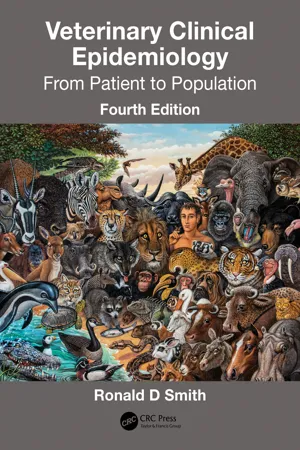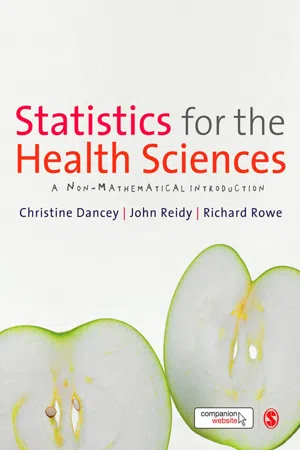Biological Sciences
Risk Factors
Risk factors are characteristics or exposures that increase the likelihood of developing a particular disease or condition. In biological sciences, these factors can include genetic predisposition, environmental toxins, lifestyle choices, and other variables that contribute to the overall risk of developing a specific health outcome. Understanding and identifying risk factors is crucial for disease prevention and management.
Written by Perlego with AI-assistance
Related key terms
Related key terms
1 of 4
Related key terms
1 of 3
4 Key excerpts on "Risk Factors"
- eBook - ePub
Veterinary Clinical Epidemiology
From Patient to Population
- Ronald D. Smith(Author)
- 2019(Publication Date)
- CRC Press(Publisher)
6 Risk Assessment and Prevention 6.1 Risk Factors and Their IdentificationAn understanding of the concept of risk is fundamental to an understanding of the subsequent chapters on prognosis, treatment, and cause. The reason is twofold. First, all analyses rely on similar approaches to organizing and interpreting the data. Second, the statistical approach to proving that relationships exist is similar. The previous chapter focused on rates and proportions. In this chapter we will also use ratios to study associations between Risk Factors and outcomes.Factors that are associated with an increased likelihood of an event occurring (such as disease) are called Risk Factors . Exposure can take place at a point in time, as when an individual comes in contact with an infectious agent or receives a drug, or may also be ongoing, like the risk of mosquito exposure for heartworm infection or cryptorchidism for testicular neoplasia.Risk Factors for many animal diseases are poorly defined or unknown and only come to light through the systematic study of naturally or spontaneously occurring cases. Clinical studies in which the researcher gathers data by simply observing events as they happen, without playing an active part in what takes place, are called observational studies . They are contrasted with experimental studies , in which the researcher determines which individuals are exposed or not exposed to the factor being investigated. Although experimental studies are more scientifically rigorous, observational studies are the only feasible way of studying most questions of risk.Observational studies are subject to many more potential biases than are experiments. Observational study designs must minimize unwanted differences between exposure groups in order to mimic, as closely as possible, an experiment. - eBook - ePub
Cardiovascular Diseases
Genetic Susceptibility, Environmental Factors and their Interaction
- Nikolaos Papageorgiou(Author)
- 2016(Publication Date)
- Academic Press(Publisher)
[1] use Risk Factors in this way to quantify an individual’s likelihood of developing disease within a given time period, such as the 5 or 10 years following the point of prediction. For the purposes of disease prediction, using such risk calculators, a risk factor need not play a causal role but must reliably associate with differences in disease risk.Figure 8.1 Relationships of Risk Factors with disease. A risk factor that has an observed association with disease risk may directly contribute to the causation of the disease endpoint (A). Alternatively, differences in the risk factor may merely reflect the presence of disease since the risk factor is influenced by the disease process itself, leading to a phenomenon known as “reverse causation” (B). Finally, a third variable related both to the risk factor and the disease may be the true causal mediator. This third variable is termed a confounder, and failure to recognize its presence may result in a causal role being erroneously ascribed to the initial risk factor (C).An observed association of a risk factor with disease risk may suggest etiological mechanisms underlying disease, and in this case a causal relationship is necessary to infer a role for the risk factor in disease pathogenesis. Closely related to this is the value of Risk Factors for indicating biological pathways that might be modulated either pharmacologically or through other interventions to prevent and treat disease. In order to act as a therapeutic or preventive target a risk factor must play a causal role in disease development. - eBook - ePub
- Christopher Dye(Author)
- 2015(Publication Date)
- Princeton University Press(Publisher)
M. africanum progress to TB disease), the numbers and characteristics of infecting cases (e.g., bacillary burden; Diekmann et al. 2010), the physical environment (humidity, sunlight, temperature, ventilation), host density (crowding, sometimes but not always demonstrable), and the age-structure of the human population. Endogenous factors include: coinfections, notably with HIV, comorbidities such as diabetes and silicosis, human genes, immunosuppressive medications, micro- and macronutrients, vitamin D, and alcohol and tobacco use (Rieder 1999; Murray 2010; Lönnroth, Castro, et al. 2010; Abel et al. 2014). The purpose of identifying such Risk Factors is first to help explain the distribution and abundance of infection and disease in populations and then to find ways of mitigating the risks to individuals and populations as a means of TB control.Risk Factors are commonly identified by comparative risk assessment (CRA)—that is, by looking for associations between TB and its putative causes based on variation among defined population subgroups. CRA, which makes use of existing differences, is just one methodological approach to the investigation of causes and risks. This chapter takes a more general, dynamic view of risk, where risks are seen as transitions among health states in a population. The task of risk assessment is to identify and measure the factors that affect these rates of transition. This places conventional risk assessment in the context of transmission dynamics, linking relative risks and attributable fractions to extinction thresholds and case reproduction numbers (Chapter 2 ). The outcome is a more comprehensive assessment of the factors that affect the distribution and frequency of TB in populations and, ultimately, a better appraisal of the options for control (Chapter 4 - eBook - ePub
Statistics for the Health Sciences
A Non-Mathematical Introduction
- Christine Dancey, John Reidy, Richard Rowe(Authors)
- 2012(Publication Date)
- SAGE Publications Ltd(Publisher)
This study estimates the prevalence of disorder in the target population. The information will be very useful for planning service provision when interpreted in the context of other similar studies. You might, however, be concerned that prevalence may be underestimated because 331 children selected for interview did not take part. If the non-participants were more likely to have disorder than children who did take part, then the prevalence figures will have been underestimated. It is unusual for researchers to be able to test this possibility directly. However, in the Great Smoky Mountains Study the sampling procedure collected a brief measure of psychopathology on an enlarged sample that included the 331 children who were not interviewed. The authors found there were no differences in the brief measure in the excluded children compared to the included sample. This indicates the prevalence estimates were not likely to have been biased markedly by non-response.BEYOND PREVALENCE: IDENTIFYING Risk FactorsFOR DISEASE
In some cases a single causal factor is both necessary and sufficient to cause a disease outcome. Huntington’s disease is a good example. A disordered copy of a particular gene is necessary for Huntington’s disease to develop and no other factors are needed to ensure the disease will develop (therefore the gene is a sufficient cause). Many other disorders involve a large number of Risk Factors that are neither necessary nor sufficient. Exposure to a risk factor of this type might increase the probability of developing a particular disease, but the disease might also manifest in the absence of the factor, albeit less commonly. Conversely, many people can be exposed to such a risk factor without developing the disease in question. For example, well-documented Risk Factors in heart disease include smoking, high body-mass index and high blood pressure. In each case these causes are neither necessary nor sufficient. Many people who smoke do not develop heart disease and many people who suffer heart disease have never smoked. However, there is a probabilistic relationship between smoking and heart disease; people who smoke are more likely to develop heart disease than non-smokers. A major purpose of epidemiology is to identify such probabilistic Risk Factors and to contribute to the multi-disciplinary effort to understand the causal pathways through which they increase risk of disease.RISK RATIOS
To begin to illustrate how epidemiology approaches this task, we can start by extending the concept of the prevalence estimate that we explained above. We will start by thinking about cross-sectional
Index pages curate the most relevant extracts from our library of academic textbooks. They’ve been created using an in-house natural language model (NLM), each adding context and meaning to key research topics.
Explore more topic indexes
Explore more topic indexes
1 of 6
Explore more topic indexes
1 of 4



